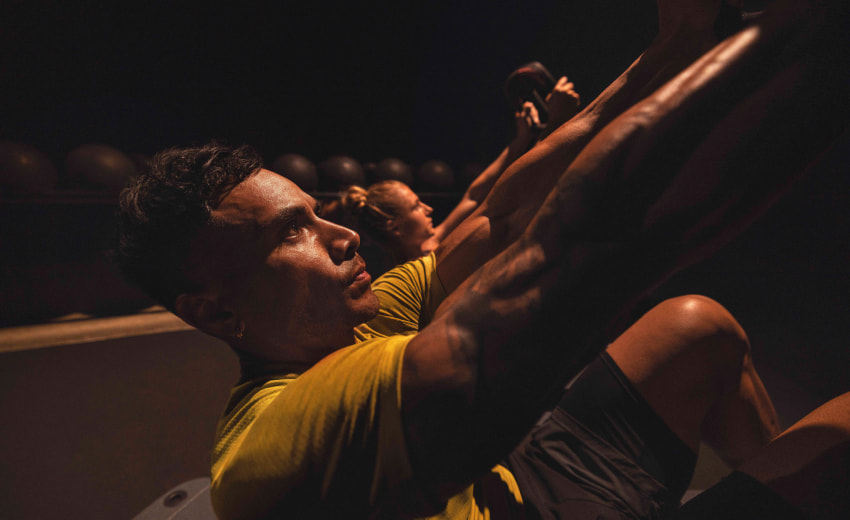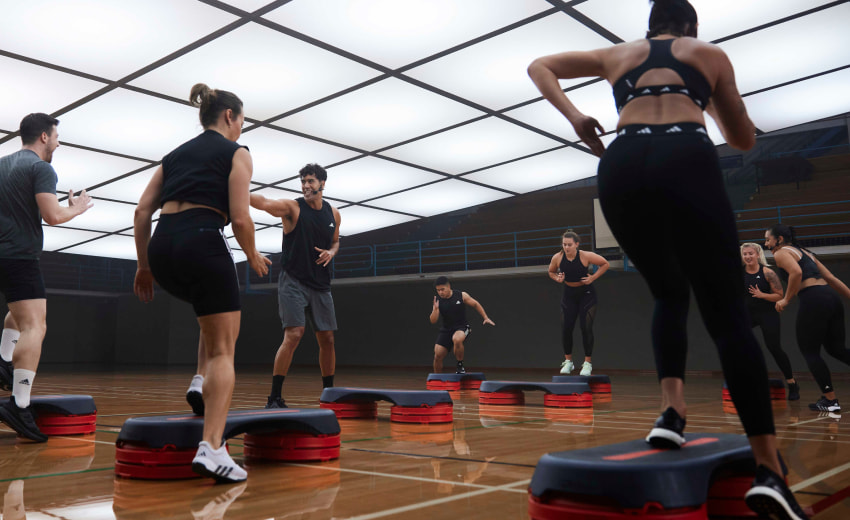
1. FOSTER A CULTURE OF CREATIVITY
Empowering your Instructors to help shape your club’s engagement strategy makes a lot of sense. After all, they know your members and their preferences best. So whether it’s seeking advice on launching the latest release, or asking them to design a member challenge, acknowledging the links between your star Instructors and the members who follow their classes is a simple uplift that benefits everyone. Sara Keller, Group Exercise Director at multi-site US operator Brick Bodies, says her Instructors are integral to the member experience.
“My Instructor team are phenomenal at creating community,” notes Sara. “My cycle crew regularly huddle for lunch and share ideas. Understanding different ways of thinking helps us create better experiences for the members. And they feel supported, which helps them in turn to support our members.”
Sara also advocates continuous professional development (CPD) for Instructors, to ensure they feel valued beyond the studio. “I communicate frequently with my Instructors because I want them to know what else is happening in our clubs and what members might be talking about. At the beginning of each year, I reach out and ask them what their goals are. Hopefully, knowing they have someone who cares to hear that makes them feel valued and important.”
2. WHERE TO FIND THEM
You don’t always have to look outside to find great talent – your next star Instructor could be right under your nose. The reasons your members are coming to the studio – to find joy through movement, get a great workout and feel part of a community – are some of the same reasons people are drawn to instructing. So it makes sense to target your most engaged participants. This approach is creating a winning culture at HealthQuest – a renowned US club with over 50 Instructors on the payroll.
Group Exercise Director Linda Romaine explains: “We place a huge emphasis on having fun and supporting each other as a team of Instructors, and aside from having an awesome time, the upshot is that it creates a joyful environment that people want to be a part of. Roughly 80% of our Instructors were members here first!”
“Sometimes we’ll be short on a particular program, so I’ll speak to the team and ask if they know anyone in their classes who might have what it takes to step up onto the stage. They obviously need to have the right movement patterns and love the class, but it’s equally important to have the right mindset and personality to really shine and bring excitement into the room.”

3. TARGETING GEN Z AND PTs
Like top sports teams, the secret to a strong Instructor squad is maintaining a steady pipeline of talent to continually raise the bar. And attracting the next generation of Instructors may require a different approach to what’s worked in the past. Sharing real-life experiences and anecdotes, plus offering full clarity around expectations and training, are key steps for assuring younger staff – especially PTs – according to Sarah Roberts, Head of Fitness at UK operator Places Leisure.
“Educating your in-house PTs on the value of group training is key,” says Sarah. “I've had conversations with PTs who we've identified as perfect for the studio, but they're fixated on personal training. As a former PT myself, I share with them how valuable it was for me to teach classes: it was one of the best ways to gain new clients, because you have a whole group of people that follow you to your different classes. You get chatting with them and next thing you know, you’re building trust and they’re considering you for PT, too.”
Sarah adds: “We also have to position the fitness industry as a career where you can progress and make good money. I go back again to the PT analogy: it’s really hard to be successful as you need a lot of clients to make the type of money that people think they're going to make. So it’s about highlighting the stability offered by group training. From there, we can start to position a career in leisure as a marathon, not a sprint.”
4. THE BEST TALENT TAKES INVESTMENT
When it comes to recruiting quality Instructors, fitness Industry veteran and author Herb Lipsman is a firm believer that you get what you pay for. And while many see threats, Herb sees the current economic climate as an opportunity to raise the bar and steal a march on their rivals.
“Given that the cost of labor in a global labor shortage is going to be higher whoever you choose to hire, I see this as a big opportunity for clubs to reinvent their recruitment strategy and set out to get the very best people they can within their given market and segment,” says Herb.
“This may cost a little more in the short-term, but in a people-centric industry, having great staff and rockstar Instructors is going to set your club apart from the competition. Your people are one advantage that your rivals can’t copy, so it really pays to get the best people.”
Despite the significant impact on club performance, bringing in top talent will add extra weight to your wage bill. But as Herb points out, creating a great culture within your organization – one of teamwork, inspiring high performance, treating everyone with dignity and respect – doesn’t need to cost anything and can be a significant draw-card for attracting even more top talent.

5. HOW TO CHANGE STRATEGY
Uncertainty is an inevitable part of change, so rallying around your Instructors and helping them to face new situations with anticipation, rather than dread, is an essential part of the process. Breaking from the status quo and embracing new opportunities was a learning curve for everyone involved at Massachusetts club, Mount Fitness. Group Exercise Manager Karin Cormier devised a bold new strategy that involved the club dramatically changing its programing, so she worked hard to ensure buy-in from Instructors and highlight the opportunities this presented.
“The team was comfortable with the way things were and it’s human nature to be afraid of change and to wonder whether you’re going to be up to teaching the new style,” Karin recalls. “I knew my Instructors had the skillset to succeed, and with the support of the excellent Les Mills Instructor Training, they were able to raise their game and reach new heights.”
Implementing the new strategy wasn’t easy, but it’s been hugely successful with group training now accounting for 80% of all check-ins to the facility.
Karin adds: “It wasn’t an easy journey and there was a bit of resistance at first among our Instructors, but when they saw my passion for where we wanted to get to as a club and they saw the quality of the Les Mills programming, they quickly bought into the project. Our Instructors are having a blast and the members are feeling it too.”
6. HOW TO LAUNCH NEW PROGRAMMING
Introducing new programming creates fresh opportunities, but a smooth rollout requires attention to the finer details – not just the exciting ones. Nailing the launch plan and studio set-up is essential, but so too is the work you put in with Instructors before members even take their first class. Jenny Au, Director of Fitness Operations at The Edge embeds a clear framework for Instructor success, ahead of any new launch.

“When it comes to launching new programming, the most important thing is making sure your team has the support they need to be successful,” she says. “That means good equipment in the studio, plus plenty of practice and team-building time before a new program launches.”
“Bringing your Instructors in to help you harness the power of social media is essential. Plan your activity, run a countdown-to-launch campaign, and ask your star Instructors to support it. Instructors are undoubtedly the heartbeat of group fitness – they’re the most important people for helping our members navigate change. When Instructors are stoked, members feel the same!”
7. LEADING YOUR TEAM THROUGH A CRISIS
As events like the COVID-19 pandemic have proven, a crisis often emerges without warning, leaving your team struggling to find level footing and unsure of the way ahead. Without proper acknowledgement of the issues staff and Instructors are facing, you risk storing issues for another day, so leading with transparency and allowing staff to share how they’re feeling is key.
Fitness professional Carrie Kepple has led teams through numerous crises, including the pandemic and a major earthquake in New Zealand in 2011. In both these situations, motivating her staff to get back to their best was an essential first step back to the new normal.
“The key to re-engaging members was to first re-engage our team,” says Carrie. “After a major setback, lots of club operators jump straight to ‘How can I get members back in?’ without thinking about their staff first, but we put a massive focus on the journey of our team.
“In both instances, the first thing we did with the team was to go into the club and just let them talk. We really made sure the team were engaged in how important they were in the member experience. The leadership and communication approach I’ve used for years is called ‘DBFCA’ whereby:
D = Desire. Create the desire to be a part of it
B = Belief. Show and prove to them that they are the solution
F = Focus. Map the focused plan
C = Commitment. Ask for their commitment
A = Action. Active the execution
Carrie concludes: “DBFCA is a great starting point for a reset, so you can focus on building both staff and member engagement through lots of interaction and the chance to commit to action with exciting relaunch events. But it’s important to keep the plan ‘tight but loose’, so you have a clear goal, but if your team comes up with ideas that are good and they’re willing to execute, let them run with that.”
READY TO UNLEASH YOUR NEXT GENERATION OF MEMBERS?
Les Mills has crafted a new series of programs to meet the specific demands of Gen Z and put your club in the fast-lane for growth. And Instructor certification for them has never been simpler.
DISCOVER MORE
